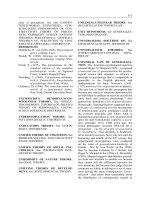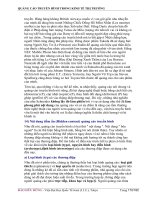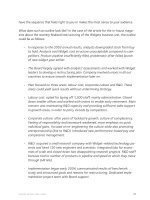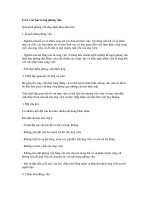Analysis of Survey Data phần 10 potx
Bạn đang xem bản rút gọn của tài liệu. Xem và tải ngay bản đầy đủ của tài liệu tại đây (68.15 KB, 13 trang )
Embrace Change 183
EXHIBIT 7.3 ABC Company Alternative Methods for
Spreading Our Mission
1. Person-to-person meetings
2. Seminars
3. Information sheets
4. Annual reports
5. Paycheck inserts
6. Invoice inserts
7. Organization letterheads
8. Internal memo letterheads
9. Group and department briefings
10. Training sessions
11. Audiovisual shows at investor conferences
12. Booths and handouts at industry meetings
13. Product and service brochures
14. New employee orientations
15. Organization-sponsored local team uniforms
16. Speeches at community functions
17. Advertisements in local school publications
18. Informal stories at organization social events
19. Networking through local service clubs
20. Individual business cards
21. Website design and content
184 EXECUTE FOR VALUE
assist in attaining the agreed-upon vision; the project tasks,
if completed, will achieve the specified results. Finally, there
must be acceptance. For example, a willingness to follow
the framework values in practice; agreement that project
completion is good for the organization.
Communication takes place in small groups where atti-
tudes are formed as well as plans made. Using sound com-
munication skills can keep the discussion on track and keep
participation positive. Generally recognized communication
skills include:
■ Using people’s names
■ Looking at people intently when they speak
■ Listening nonjudgmentally
■ Rewording questions to ensure understanding
■ Responding in a positive manner with a positive phrase
■ Saying so when you do not know the answer
■ Encouraging input from all participants
■ Avoiding arguments
■ Sidestepping foolish questions
■ Relating to participants in a kind and gentle way
Organizations also communicate symbolically through
language, signs, ceremonies, and events. For example, hotel
employees are more likely to treat customers better if they
think of them as guests rather than boarders; a sign with
three lights out at the entrance to the best restaurant in the
city does not indicate a first class establishment; employee
award banquets communicate what types of behavior the
organization truly encourages; and the location of the
annual holiday party reveals how much the organization
values its employees.
Embrace Change 185
Empowerment The language used by superiors to empower
their subordinates has a great deal to do with how effectively
they are able to motivate them. Phrases such as, “I won’t, we
can’t, they don’t know how,” seldom instill the desire to learn
or perform at one’s highest level. However, providing gentle
instruction and information couched in phrases such as, “We
can, I will, they did it!” builds confidence and skills in all
team players.
One of the advantages of having a vision and values that
become part of the personality of the workforce is that it
enables management to push decision making down to the
appropriate level—the people in the field who are best able
to assess the current situation. Successful delegation
involves an ability to communicate clearly and effectively. It
also requires a desire to provide adequate support and an
ability to obtain commitments. The following guidelines
may be useful in this regard:
■ Describe what needs to be done and when.
■ Explain the results anticipated and the measurements to
be used.
■ Point out possible hurdles to overcome.
■ Place the task within the context of the framework so its
relevance is clear.
■ Provide the resources required for successful completion,
■ Obtain a firm commitment to perform and an
acceptance of the job.
■ Grant the authority required, including interfaces with
other departments.
Another aid to empowering employees is a good story.
By sharing an example of others who got a tough job done
186 EXECUTE FOR VALUE
or creatively solved a problem on their own, you are
demonstrating a positive approach and the realm of possi-
bility open to the empowered.
Leadership It is at the top of the organization where the abil-
ity to encounter, embrace, and exploit change is predeter-
mined. This is where a positive attitude in responding to
change and dealing with risk sets the tone for the how the
entire organization acts.
Leaders and how they spend their time are noticed. Do
not expect an organization where the leader spends no time
monitoring the competition, checking up on project plan
completions, tracking the returns on investments, or tweak-
ing the strategic framework to be very good at dealing with
change, restructuring the culture, maximizing organization
value, or planning for the future.
Effective leadership in response to change requires set-
ting an example. When the organization needs to be
rearranged, people notice who gets promoted and for what.
The leader who outwardly professes to believe in the value
of rewards based on merit, yet promotes staff members
based on time in grade sends a mixed message. The one that
employees receive is the one conveyed by what actually hap-
pens, not what is spoken or written in a framework.
Employees also are sensitive to how the organization’s
money is spent in the process of change. A leader who
scrupulously reviews prospective investments for appropri-
ate returns and makes expenditures commensurate with the
organization’s vision and values reinforces the strategic
framework and sets an example for all his managers to fol-
low. One who spends the organization’s money on low-
return pet projects and no-return perquisites also sets an
example. In this case, however, it is not one of maximizing
the organization’s value or the security and happiness of its
employees.
Leaders who deal effectively with change generally have
the ability to:
■ Listen carefully to learn the source and nature of change.
■ Anticipate the direction of change based on small shifts
in trends.
■ Probe as deeply as necessary to retrieve important
details.
■ Build solid, trusting relationships with outside advisors.
■ Maintain a flexible approach to achieving objectives.
■ Act in a courageous, calm, and decisive way when
required.
When these abilities are combined with a knack for
motivating people, a commitment to framework vision and
values, and the discipline to operate within the required
return constraints, the leader is well on the way to enhanc-
ing the organization’s value over the long term. That is,
strategic leadership assists the organization in anticipating
and initiating changes that will ensure its future viability.
EXECUTE THE FRAMEWORK
This section provides a review of the execution process in the
context of the strategic framework as a whole. The summary
which follows it reviews all seven steps covered in this book
that lead toward maximizing the organization’s value.
Execute the Framework 187
188 EXECUTE FOR VALUE
The best strategic document will be useless if it does not
prove possible to implement the framework that has been
formulated. Whether it can be successfully executed very
largely depends on whether it proves possible to direct the
organization’s efforts toward the niches and long-term goals
that define its vision. This requires more than simply initiat-
ing a few selected measures. All activities, departments, and
decisions should be justified only if they build or sustain the
chosen niches and supporting long-term goals.
The main aim of strategic framework design is to define a
few central and key factors in the form of viable niches and
orient all the organization’s resources toward their achieve-
ment. It is then that the individual areas and divisions of the
organization will no longer operate in isolation, directed by
the considerations of their specific interests. Instead, they will
be concentrated on the organization’s chosen niches.
Once consensus is reached on the action plans, the exe-
cution of the framework begins in earnest. The framework
becomes meaningful when it leads to concrete action in the
real world, where successful implementation is the result of
having small decisions made strategically every day. Well-
conceived and -communicated execution ensures this result
is achieved. It consistently raises the organization’s level of
operational efficiency and, hence, cash flow.
SUMMARY
The overall process discussed in this book covers seven
steps which deal with:









